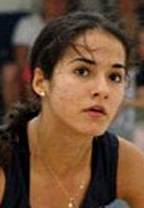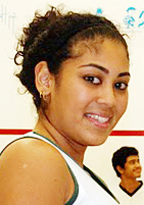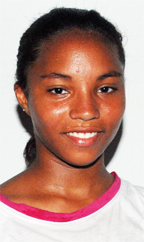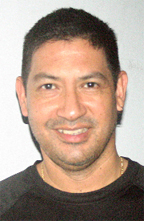By Donald Duff
Congratulation are in order for the Guyana Squash Association (GSA) whose junior national team once again dominated the annual Caribbean junior championships which ended recently in the Cayman Islands.

They players then went to the tough Central American and Caribbean Games where they earned three of the 10 medals won by this country.
Nicolette Fernandes earned a brone medal in the women’s singles and teamed up with Ashley Khalil to win a silver medal in the women’s doubles while the women’s team also gained a bronze medal.
Though the juniors failed to sweep both team titles as they did last year in Barbados, the boys and girls’ teams showed the strength of the local junior players by reaching the finals of both categories.
The Guyana junior girls’ team was undoubtedly the success story of the championships winning a hat-trick of regional titles while the boys reached the finals before losing 2-3 to the hosts.
In the individual singles competition the Guyanese lasses sped to three individual gold medals through Ashley Khalil, Mary Fung-A-Fat and Victoria Arjoon in the U-19, U-17 and U-15 categories.
The Guyana team added a fourth individual singles gold medal through Jean Claude Jeffrey in the boys’ U-15 category.

The performances, apart from underlining the strength of the game locally, is a fillip for the GSA’s programmes and coach Carl Ince, one of the more qualified coaches in the Caribbean.
Keisha Jeffrey and Ashley Khalil continued their rivalry with Khalil getting the better of Jeffrey on this occasion.
In 2008 Jeffrey beat Khalil in the final of the women’s singles competition to carve a niche in the sport as the youngest national champion. She also defeated her in last year’s final. This year, however, a determined Khalil got past both Jeffreys’ Kayla in the semifinals and Keisha in the finals to become the new champion.
The performances in the Cayman Islands might give the impression that the game is widely spread here and that there are many facilities for aspiring youngsters to practice. The opposite is the case.
The game is mainly played in Georgetown by a handful of youngsters who came from fairly affluent backgrounds.
Most of the tournaments are held at the courts of the Georgetown Club and there are a couple other courts around at the Everest Cricket and the Georgetown Cricket Clubs.

Squash Racquet Centre
The new squash facilities being constructed by the Government of Guyana is a deserving fillip for the GSA and the sport in light of the outstanding achievements of local squash players including current treasurer Garfield Wiltshire over the years.
The centre, which is being built on Woolford Avenue, is expected to cost the government some 28.7m dollars
And will include two squash courts which will cost 20.35 million dollars to build. It will also include two practice courts at a cost of 4.2 million dollars.
If the erection of the courts result in more Guyanese playing the sport then the money would have been well spent because after all squash is not a spectator sport played as it is in an enclosed arena where one can only watch from above.
“I think this would be the first publically-owned squash court in Guyana and the development of this project, started with a discussion between the President, His Excellency Bharrat Jagdeo and the Guyana Squash Association,” Minister of Culture, Youth and Sport Dr. Frank Anthony said last December.
The completion of the centre should boost Guyana’s chances of staging next year’s junior championships.

A member of the GSA had previously told Stabroek Sport that although the GSA’s junior programme is open to everyone and is affordable, access to facilities was limited.
This continues to be the case and despite their success curent president Andrew Arjjon and his executives must seek to decentralize the sport.
Nicolette’s feat
Another decision for the GSA is whether they will continue to allow world ranked women’s squash player Nicolette Fernandes to compete in the men’s category of the national championships.
Earlier this month Fernandes created history by winning both the men’s and women’s singles titles at the National Championships.
It was third time lucky for Fernandes who had also participated in the 2008 and 2009 national championships losing to
Kristian Jeffrey in 2008 and Reagan Pollard last year both times at the semi-final stage.
There are some who believe that the GSA should not have allowed Nicolette Fernandes to play in the men’s category because of the fact that she has not qualified in one respect – she is not a man.
One can recall in 1999 that Serena Williams wanted to play on the men’s tour. Women’s tennis is boring, I can beat the men,” said Williams back then.
But the ATP backed the ruling against Williams competing on the men’s tour.
“The ATP Tour is the official circuit of men’s professional tennis tournaments. Unles Serena can qualify for the key word- men’s – there is a technical problem,” said Graeme Agars, the ATP vice president communications.
While some people see no problem in allowing women to compete in male only events the opposite is not the case and men are expressly forbidden to participate in women’s sports as South African Caster Semenya can attest
Semenya shot to prominence when she won a gold medal at the 2009 World Championships in Berlin but then achieved even more notoriety when it was alleged that she was a man and requested to undergo a gender test.
After some 11 months in limbo Semenya returned to competition winning her comeback race earlier this month in Finland.
One wonders whether the decision to allow Fernandes to play in the men’s category of the national championships is a special one or whether any female will be allowed to enter future events? The GSA needs to be careful here for there are lots of implications in allowing `Battle of the Sexes’ type situations to permeate the sport.
Funding
Like most associations squash too is affected by the lack of funding to drive its programmes. The GSA has been a model for most associations in the field of accountability and transparency. The GSA because of their track record and the success of the national squash teams and the world ranking of Fernandes should easily qualify for government funding but until the National Sports Policy is completed and it is known whether the government will introduce the policy of providing grants to sports associations to help them push their developmental programmes the onus will be on the private sector to continue to support the GSA.
For after all, four individual junior Caribbean singles champions, a gold and a silver medal in teams at the regional level and one silver and two bronze medals at the CAC Games are all reasons for patriotic Guyanese to smile and feel proud about.




